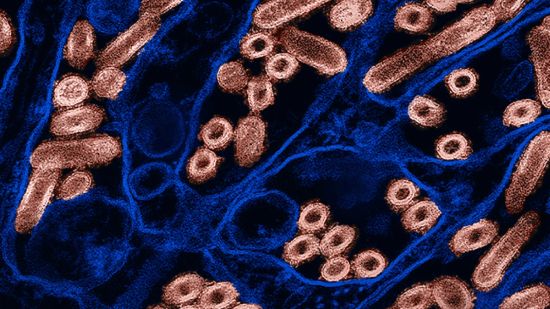New roles in infectious process for molecule that inhibits flu
In study, lack of immune protein increases risk of infection by unfamiliar viruses
Emily Caldwell
Ohio State News

Colorized micrograph of avian influenza A H5N1 virus particles (in pink). This flu is widespread in wild birds worldwide and causing outbreaks in poultry and U.S. dairy cows. To date, 45 human cases have been reported.
Image: CDC, NIAID
Nov 14, 2024 — Researchers have identified new roles for a protein long known to protect against severe flu infection – among them, raising the minimum number of viral particles needed to cause sickness.
The protein also helps prevent unfamiliar viruses from mutating after they infect a new host, the study found – meaning its absence during an immune response could enable an animal virus spilled over to people to adapt rapidly to human hosts.
The combined findings by scientists at The Ohio State University add up to potential trouble for people deficient in the protein, called IFITM3 – especially if an avian or swine flu were to gain hold in humans and cause widespread disease.
IFITM3 deficiency is not rare: About 20% of Chinese people and 4% of people of European ancestry have genetic mutations that disable the immune system’s production of the protein.
“An IFITM3 deficiency makes it easier for a low dose of virus to be infectious,” said senior study author Jacob Yount, professor of microbial infection and immunity in Ohio State’s College of Medicine.
Currently, the Centers for Disease Control and Prevention is tracking the H5N1 avian flu that is widespread in wild birds worldwide and causing outbreaks in poultry and U.S. dairy cows. To date, 45 human cases have been reported.
“It’s these emergent viruses that we’ve never encountered before where IFITM3 is really the most important,” Yount said. “Our study supports the idea that not only would you get a more severe infection, but you’re more likely to get infected in the first place and more likely to help the virus adapt if you are IFITM3 deficient.”
The research was published Oct. 30 in Nature Communications.
IFITM3 (pronounced I-fit-M-3, for interferon-induced transmembrane protein 3) is key to the innate immune system’s clearance of viruses. It is produced in large quantities after flu is present and lowers the severity of infection by sequestering the virus so that it can’t make copies of itself, or replicate.
Yount has studied flu and this protein for years, and his lab developed a mouse model lacking the gene that codes for IFITM3 – making the animals highly susceptible to flu.
In this new work, his team sought to extend what is known about IFITM3 to risks related to interspecies infection – specifically the spillover of avian or swine flu to humans, which caused the 1918 influenza pandemic and three others since.
The researchers compared the infectiousness of two strains of avian flu, including H5N1, at different viral particle levels in mice lacking the IFITM3 gene and normal mice. At levels roughly equivalent to 10 and 50 particles, viral loads could be detected in all mice, but in the protein-deficient mice, the equivalent of a single viral particle was able to cause infection and inflammation – while normal mice could not be infected by the low dose.
“IFITM3 has been known to prevent severity of infection, but we’re newly showing that it’s also controlling how much virus it takes initially to cause infection,” Yount said. “And I think that’s one of the most fundamental textbook-level findings ever to come out of my lab.”
Additional experiments in cultures of human cells that line the lung and immune cells showed that cells in which the gene for IFITM3 was silenced were more susceptible to infection by 11 avian, three swine and two human influenza viruses.
“Every single one of those viruses infected at a higher rate when IFITM3 was deficient. So this really seems to be a universal property where IFITM3 needs to be there to inhibit flu infections,” Yount said.
The team then used lab techniques to mimic repeated transmission of a human-origin virus in mice, testing the protein’s role in the pace of mutations that lead to interspecies adaptation. Experiments showed that flu viruses were able to replicate more rapidly and induce higher levels of inflammation in mice deficient in IFITM3 compared to normal mice.
“So a virus from a different species adapts faster when IFITM3 is not there. This was a proof of principle, because we’re testing it in a mouse,” Yount said.
“Overall, our study is a demonstration that IFITM3 is broadly important for zoonotic virus defense against a whole range of different influenza viruses that could potentially infect humans. And our research suggests that people with hereditary deficiency in IFITM3 are a uniquely vulnerable population for new viruses from animals entering humans.”
The research suggests that individuals with IFITM3 deficiency should be considered in pandemic prevention efforts, he said.
This work was supported by grants from the National Institutes of Health.
Co-authors are Parker Denz, Samuel Speaks, Adam Kenney, Adrian Eddy, Jonathan Papa, Jack Roettger, Sydney Scace, Emily Hemann, Adriana Forero and Andrew Bowman of Ohio State, and Adam Rubrum and Richard Webby of St. Jude Children’s Research Hospital.
Source: Ohio State News
https://news.osu.edu/new-roles-in-infectious-process-for-molecule-that-inhibits-flu/
Contact:
Emily Caldwell
Assistant Director, Research Communications
The Ohio State University
Office of Marketing and Communications
University Square South, 2nd Floor
15 E. 15th Ave., Columbus, OH 43201
614-292-8152 | Office
caldwell.151@osu.edu / news.osu.edu
"Reproduced with permission - The Ohio State University"
The Ohio State University
For more HIV and AIDS News visit...
Positively Positive - Living with HIV/AIDS:
HIV/AIDS News |